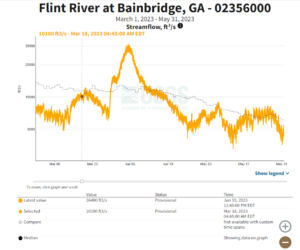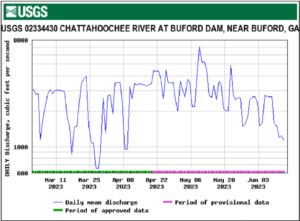Where has all the water gone?
Article Extracted from the Summer Kick-Off 2023 Newsletter
Written by Clyde Morris
Lanier was above summer Full Pool level on May 1 at 1071.05, down 1.3 ft. from a month earlier. By May 31 it was down to 1068.95, a drop of 2.1 feet. Perhaps you’ve wondered why.
Most crucial to springtime Lanier levels are, of course, the reservoir’s starting point, but also how much, where, and when rain falls in the ACF basin. On March 1, Lanier was at 1070.70, so essentially full. But, according to the U.S. Geological Survey, rainfall during May totaled only 1.61”, compared with a historical average of about 4.5”.
Compounding the shortfall in rain, during the Gulf sturgeon’s spawning season (March to May), the Corps operates Jim Woodruff Dam, the furthest-downstream dam in the system, to support spawning. And while the Corps is trying to provide enough water for the Gulf sturgeon, it is also trying to keep all three conservation reservoirs at comparable levels, relative to their full pools. So, if rainfall is below normal in the middle of the system, then additional flow is taken from the reservoirs upstream to compensate.

The wild card is the Flint River, which spans about 55% of the ACF’s drainage basin above Lake Seminole, the farthest-downstream dam in the system. The Flint has no dams and therefore cannot be controlled to help manage levels in the conservation reservoirs, including Lanier.
When Flint River flows are low, then Chattahoochee flows have to make up for them – and Lanier, being the farthest-upstream reservoir in the system, is the last resort for stored water. As you can see from the graph (left), the Flint’s flows from March through May were below the historical average for all but about two weeks.
The lower-than-normal flows in the Flint required additional water to be released from Buford Dam to maintain minimum required flows at the Florida state line. That, combined with lower-than-normal inflows to Lanier, caused Lanier’s level to fall. The good news is that, as of June 1, the Gulf sturgeon spawning season was over and lower flows into the Apalachicola are now happening, as shown on the graph (right):

This should reduce the strain on Lanier, and signs are it is already stabilizing lake levels, as Lanier has dropped only three inches since June 1, as of the date of this writing. If higher-than-normal rains occur – which is possible, given the re-establishment of an El Nino condition in the Pacific – then we could possibly even see levels rise, although that is the opposite of what normally happens in the summer. One can only hope….
This article was featured in the 2023 Summer Kick-Off Newsletter. To view the full Newsletter please visit – www.lakelanier.org/get-involved/newsletters-and-webinars/


